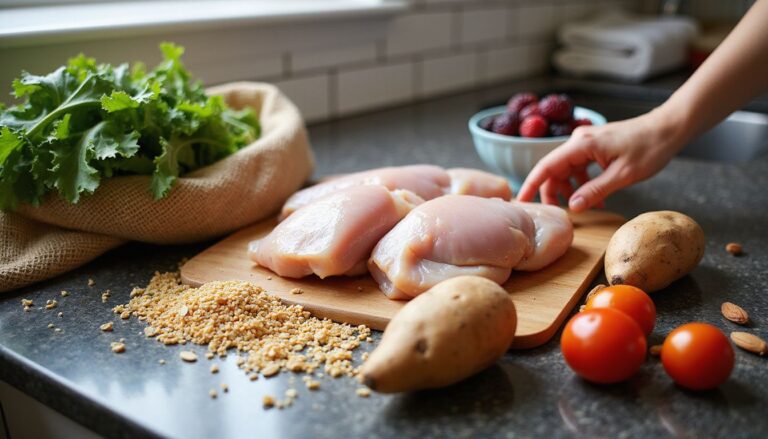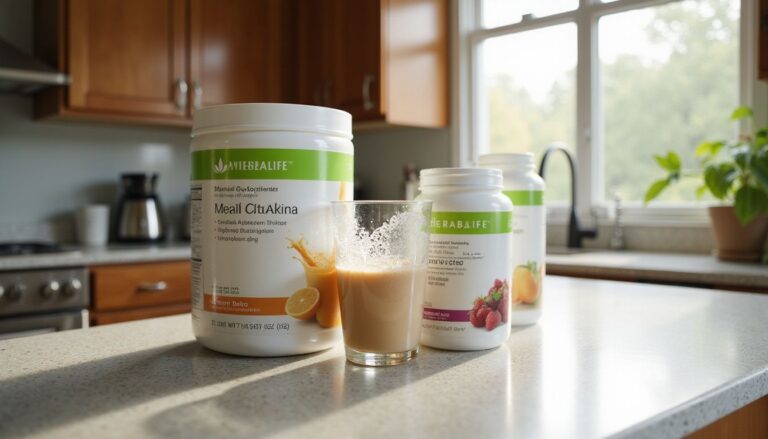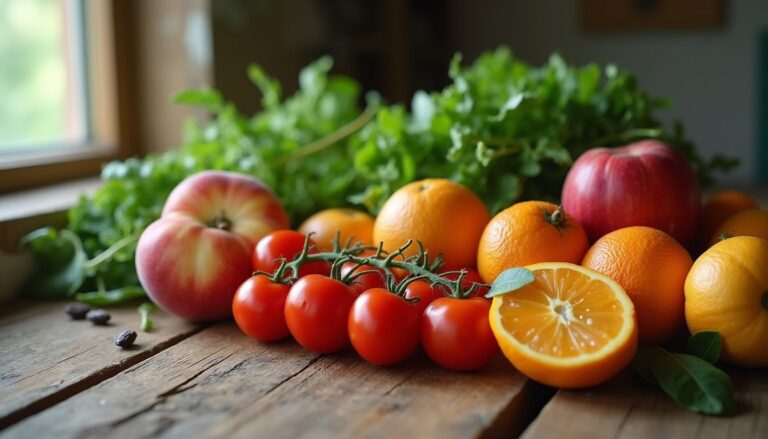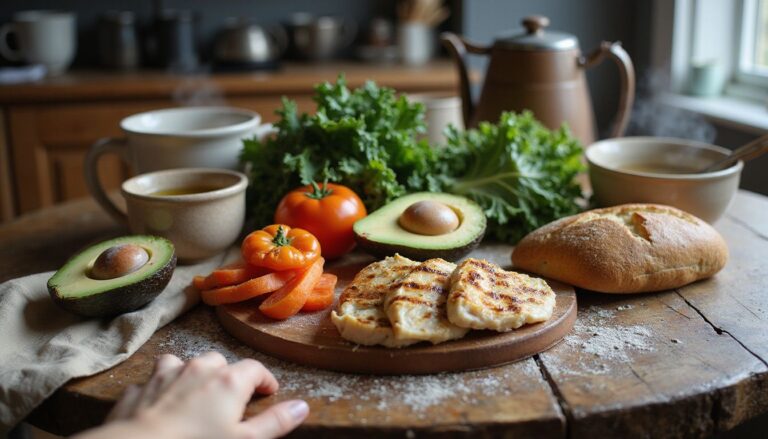Diet For Weight Loss For Females: Lose Weight, Count Calories, And Achieve Better Health
Our Nutrition Assistant AI Suite will transform your body. You will lose fat, get toned, and build muscle. Gain confidence and optimal health.
You might feel stuck trying to lose weight or keep a healthy weight despite many plans. In the United States, about two out of three adults live with overweight or obesity, which raises the risk for type 2 diabetes and heart disease [1].
This guide on Diet For Weight Loss For Female shows how a simple calorie plan, smarter food choices, and an evidence-based meal plan can move you forward. You will find clear steps for healthy eating, practical tracking tips, and ways to stay motivated.
Start reading to learn how small daily changes support better health over time.
…
[1] Centers for Disease Control and Prevention (CDC). Adult Obesity Facts. https://www.cdc.gov/obesity/data/adult.html.
Key Takeaways
- About two out of three adults in the U.S. have overweight or obesity, which raises risks for type 2 diabetes and heart disease (CDC).
- Creating a daily calorie deficit of 500 to 1,000 calories can help females lose about 1 to 2 pounds per week safely (Mayo Clinic Diet).
- Balanced macronutrients along with high fiber foods, lean protein, whole grains, vegetables, nuts, and healthy fats support weight loss and good nutrition.
- Limiting processed foods, refined carbs, added sugars in drinks, and excess sodium lowers chronic disease risk and supports healthy weight management (AHA; Harvard Health).
- Pairing healthy eating patterns such as the Mediterranean or plant-based diets with regular exercise improves results and supports long-term success.
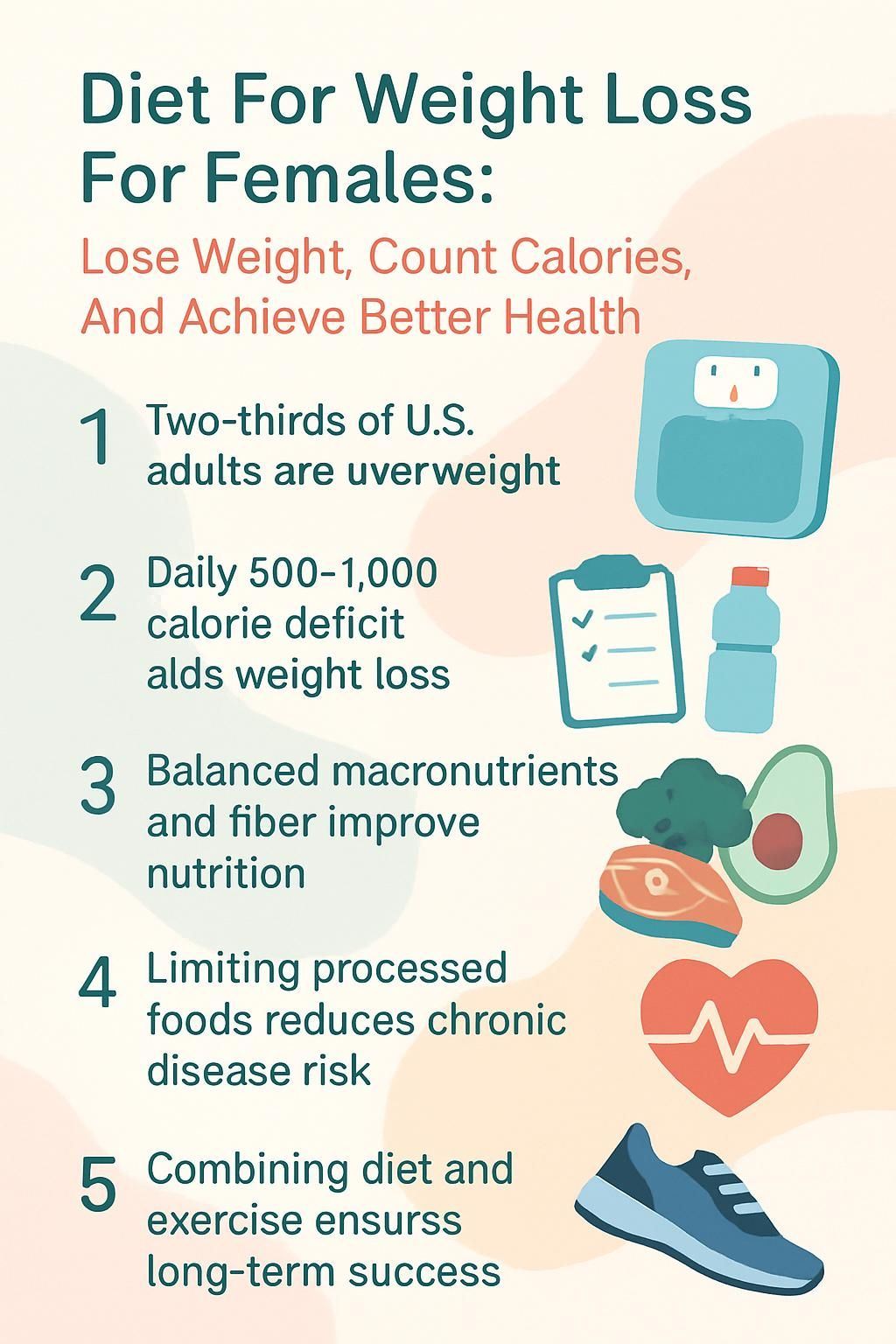
Understanding Weight Loss for Females

Knowing how your body uses calories makes meal choices easier. A little nutrition knowledge can turn hard changes into doable habits.
Why is a Calorie Deficit Important for Weight Loss?
Weight loss happens when you burn more calories than you eat, which is called a calorie deficit. If you maintain weight at 2,000 calories and eat 1,500, your body uses stored fat for energy.
Most guidelines suggest a daily deficit of 500 to 1,000 calories. This usually leads to losing about 1 to 2 pounds per week, which is considered safe. Studies from the Mayo Clinic Diet and clinical trials support steady deficits for lasting results while protecting muscle.
Many diet strategies, including intermittent fasting and low-calorie plans, work through this same principle. You often see better progress with portion control and nutrient-dense foods instead of quick fixes.
Successful weight loss needs some calorie restriction, which creates a gap between what you eat and what your body uses.
How Does Nutrition Affect Weight Management?
Nutrient-rich foods help you lose weight and keep it off. Whole grains, fruits, vegetables, lean protein like fish or eggs, and healthy fats such as nuts support steady progress.
Cutting processed foods reduces added sugars and refined carbs, which often drive weight gain. Fiber from beans, vegetables, and whole grains boosts fullness. Including protein at breakfast can reduce hunger later compared with a high-carb breakfast.
Water also helps. It supports energy balance and replaces sugary drinks. Evidence-backed patterns like the Mediterranean diet or low-fat plans can lower disease risk while you work toward long-term weight loss.
Key Components of a Weight Loss Diet
Think of these core pieces as your daily toolkit for healthy weight reduction.
What Are Balanced Macronutrients and Why Do They Matter?
Your body needs a mix of macronutrients: carbohydrates, protein, and fat. Carbs, especially from whole grains and fruit, give energy for daily activity. Protein helps you feel full and protects muscle during a calorie deficit. Healthy fats from olive oil, nuts, and seeds support heart health and hormones.
Without this balance, cravings can rise and energy may dip. A 2022 review found higher protein diets lead to more fat loss with better muscle retention than low-protein plans. In my own planning, adding fiber-rich carbs at lunch kept me satisfied and helped me skip candy in the afternoon.
Balanced macronutrients make each bite work harder for your goals, helping you lose weight while staying healthy.
Why Should You Eat More Fiber-Rich Foods?
Fiber-rich foods like vegetables, fruits, whole grains, nuts, and legumes fill you up fast yet stay low in calories. Aiming for 25 to 30 grams of fiber each day supports portion control and reduces cravings.
Fiber slows digestion and steadies blood sugar, so hunger hits less often. Adding beans or oats to meals is a simple way to get there. During a free NHS weight loss plan challenge, switching white rice to brown rice kept me full longer and made snacking easier to manage.
How Much Water Should You Drink for Weight Loss?
Hydration supports your weight-loss program. Most people do well with about 8 to 10 cups of water daily, or roughly 2 to 2.5 liters. A glass of water before meals may lower intake because it helps you feel full.
If you follow a very-low-calorie plan, or if you exercise or live in heat, increase your fluids. Carry a reusable bottle to avoid sugary drinks that add calories without nutrition. Research links good hydration with healthier eating habits and better outcomes.
Popular Diet Strategies for Females
Different routes can lead to the same destination, so choose the one you can stick with.
What Is a Low-Calorie Diet?
A low-calorie diet sets daily intake around 1,000 to 1,500 calories for many adults. This creates a calorie deficit, which is the key driver of fat loss. Careful tracking helps, and meal replacements can make monitoring easier.
Studies show low-calorie plans can lower risks for type 2 diabetes, high blood pressure, stroke, and sleep apnea. Check with a health care professional before starting, especially if you are pregnant or have a medical condition.
How Does a Low-Carbohydrate Diet Work?
Lowering carbs can reduce insulin levels, which encourages your body to use stored fat for energy. This approach centers on lean protein, eggs, yogurt, nuts, and non-starchy vegetables while limiting bread, pasta, rice, potatoes, and sugary snacks.
Several meta-analyses report greater short-term weight loss with low-carb diets compared with low-fat diets at about six months. A 2020 review found larger reductions in abdominal fat and improvements in heart health markers for women who chose lower carb patterns. Combining carb control with calorie tracking often delivers the best results.
What Are the Benefits of a High-Protein Diet?
Higher protein intake increases fullness, which can reduce snacking and portion sizes. Clinical trials show high-protein diets help people lose more fat while keeping more lean mass compared with lower protein plans.
Your body also burns more calories digesting protein, a process called diet-induced thermogenesis. Good sources include fish, chicken, Greek yogurt, tofu, eggs, nuts, and legumes. During my own effort to follow evidence-based guidelines like DASH, adding lean protein to every meal helped me feel satisfied longer.
Why Choose the Mediterranean Diet?
The Mediterranean diet focuses on fruits, vegetables, whole grains, legumes, nuts, olive oil, and regular fish, with less red meat and sweets. People who follow this pattern often lose modest amounts of weight and keep it off compared with standard low-fat diets.
Research, including systematic reviews, links this plan with improved heart health and a lower risk of type 2 diabetes. I once swapped processed meat sandwiches for salads with extra virgin olive oil, and my blood pressure improved within a few months. You can download the free NHS Weight Loss Plan to track meals while trying this approach.
How Does Intermittent Fasting Help Weight Loss?
Intermittent fasting limits eating to set windows, which can reduce daily calories without counting every bite. A common method is 16:8, which means fasting for 16 hours and eating during an 8-hour window.
Some research suggests fasting lowers insulin levels and may support fat use. Many people find cravings decline with a clear schedule. If you prefer fewer decisions each day, intermittent fasting can simplify your routine.
Additional Dietary Options
Several other eating patterns can work if they match your lifestyle and medical needs.
What Is the Ketogenic Diet?
The ketogenic diet is high in fat, moderate in protein, and very low in carbohydrates, usually 20 to 50 grams per day. This can shift your body into ketosis, where it burns fat for energy.
Foods include eggs, nuts, fish, avocados, olive oil, cheese, leafy greens, and meats. You limit bread, pasta, most fruit except berries, and sugary foods. Studies show keto can jump-start weight loss for some people. During my two-week trial, hunger dropped between meals, yet social meals were tougher to manage.
How Do Vegetarian and Vegan Diets Support Weight Loss?
Vegetarian and vegan diets emphasize fruits, vegetables, legumes, whole grains, and nuts or seeds. These meals are high in fiber and usually lower in calories than meat-heavy dishes.
A 2022 meta-analysis found people on plant-based diets lost more weight over six months than those on omnivorous diets. When I swapped cheese for beans and added chickpeas to salads, I felt full longer and ate fewer calories.
What Are the Advantages of a Low Glycemic Index Diet?
Low glycemic index diets use foods that digest slowly, which steadies blood sugar and energy. Choices include lentils, oats, nuts, fruits, and many vegetables.
Harvard Health notes that low GI patterns are linked to lower risks of type 2 diabetes and heart disease. Many people find these meals satisfying and easier to maintain than fad plans. After switching to low GI lunches, I had fewer afternoon slumps at work.
Summary: A low GI approach can deliver steady energy, fewer hunger spikes, reduced disease risk, and higher diet stickiness over time.
What Is the Paleolithic Diet?
The Paleolithic, or paleo, diet focuses on foods similar to those eaten before farming. You eat lean meats, fish, vegetables, fruits, nuts, and seeds. You avoid processed foods, dairy, grains, added sugars, and legumes.
Mayo Clinic notes paleo meals are high in protein and fiber and low in refined carbs. A friend followed a paleo plan for four weeks with calorie tracking and felt fewer cravings and more consistent energy. The focus on whole foods can reduce calories naturally without feeling deprived.
Meal Planning for Success
Planning bring structure to your day, which makes progress easier to repeat.
What Are the Benefits of Having a Meal Plan?
A weekly meal plan helps you control calories and avoid last-minute choices. It balances nutrients and makes it easier to add more fiber-rich foods, fruits, vegetables, and lean protein.
Planning also saves money by cutting impulse buys. A set schedule supports steady habits and reduces weight cycling. Tracking your meals helps you adjust based on real results.
What Does a 7-Day, 1200-Calorie Diet Plan Look Like?
A 1,200-calorie plan can support gradual loss for smaller or less active adults. It should be nutrient dense and protein forward.
- Breakfast under 300 calories: oatmeal with nuts and berries or a boiled egg with whole-grain toast and fruit.
- Lunch with lean protein: grilled chicken or beans, plus vegetables and a small serving of brown rice.
- Dinner built on fiber: baked salmon with broccoli or tofu stir-fry with quinoa and mixed vegetables.
- Smart snacks: Greek yogurt, carrot sticks, or an apple within your daily target.
- At least five servings of fruits and vegetables daily for fiber and vitamins.
- Water goal: about eight cups to support metabolism and fullness.
- Limit highly processed foods that are high in sodium, added sugars, and refined carbs.
Talk with a clinician before starting very-low-calorie plans, especially if you have a medical condition.
How Can You Practice Portion Control?
Use smaller plates and bowls to serve less food. People often eat fewer calories with a 9-inch plate than with a larger one.
Measure portions for calorie-dense foods like pasta, rice, and nut butter. Read labels for serving sizes. Eat slowly and stop when you feel satisfied instead of stuffed.
Pre-portion snacks into small containers, and fill half your plate with vegetables. These steps make calorie control easier without complicated math.
Foods to Include in a Weight Loss Diet
Pick foods that work hard for you, not against you.
Which Lean Proteins Are Best for Weight Loss?
Skinless chicken, turkey, white fish like cod or tilapia, and shrimp offer high protein with fewer calories. A 3-ounce serving of grilled chicken has about 26 grams of protein and roughly 140 calories.
Tuna canned in water is a quick option. Greek yogurt and low-fat cottage cheese provide protein and calcium. Egg whites offer protein with very few calories. Tofu and tempeh work well for plant-forward eating. Pair these with whole grains for balanced meals.
Why Are Whole Grains Important?
Whole grains bring fiber, vitamins, and minerals that help you stay full and support health. People who eat more whole grains often weigh less than those who rely on refined grains.
Whole wheat bread, brown rice, oats, and quinoa stabilize blood sugar and may lower the risk for heart disease and type 2 diabetes. When I swapped white rice for brown rice, I stayed satisfied longer and snacked less.
What Fresh Fruits and Vegetables Should You Eat?
Berries, apples, oranges, and pears add fiber and vitamin C. Berries also provide antioxidants linked to heart health. Lower-calorie fruit supports a calorie deficit without leaving you hungry.
Leafy greens such as spinach, kale, and romaine boost nutrients for very few calories. Add broccoli and cauliflower for fiber and compounds that reduce inflammation. Carrots, bell peppers, tomatoes, cucumbers, and zucchini round out a colorful plate.
Which Healthy Fats Support Weight Loss?
Healthy fats help with fullness and hormone balance, which can make a calorie deficit easier to maintain. Great sources include avocados, olive oil, almonds, walnuts, chia seeds, flaxseeds, and fatty fish like salmon and sardines.
Replacing saturated fat with unsaturated fat supports heart health and weight management. The American Heart Association and Harvard T.H. Chan School of Public Health note links between unsaturated fats and smaller waist sizes. Add nut butter to oatmeal or drizzle extra-virgin olive oil on salads for satisfying meals that support your plan.
– American Heart Association (AHA), 2023: “Dietary Fats”
– Harvard T.H. Chan School of Public Health: “The Nutrition Source – Fats & Cholesterol.”
Foods to Avoid or Limit
Some foods make weight control harder than it needs to be.
Why Avoid Processed Foods?
Processed foods often pack added sugars, unhealthy fats, and sodium. These add many calories but few nutrients.
People who eat more ultra-processed foods tend to weigh more and face higher risks for heart disease and type 2 diabetes. Choosing whole grains, fresh fruits, vegetables, nuts, and lean proteins helps you feel full longer and aligns with a healthy diet.
How Do Sugary Beverages Affect Weight Loss?
Soda, sweetened teas, and energy drinks deliver lots of sugar with almost no nutrition. A 12-ounce soda has about 39 grams of sugar and roughly 150 calories, which do not curb hunger.
Regular intake makes a calorie deficit harder to reach. These drinks are linked to higher obesity rates across many groups. During my own tracking, cutting sweetened drinks made it easier to control hunger and stay within my calorie goal. Choose water or unsweetened tea instead.
What Are Refined Carbs and Why Limit Them?
Refined carbs include white bread, pastries, many cereals, and sugary drinks. Processing removes fiber and nutrients, yet calories stay high. They can spike blood sugar, then leave you hungry soon after.
High intake is linked to higher body weight and a greater risk of type 2 diabetes. Replacing refined products with whole fruits, vegetables, oats, and whole grain breads supports weight loss and heart health.
…
Reference:
1. “Whole-grain intake and cancer: an expanded review and meta-analysis,” The American Journal of Clinical Nutrition, August 2011.
How Does Excessive Sodium Impact Health?
Too much sodium can raise blood pressure, which increases the risk for heart disease and stroke. The Dietary Guidelines for Americans suggest most adults limit sodium to 2,300 milligrams per day.
High sodium intake can cause water retention and bloating. Over time, it strains the kidneys and can contribute to bone loss. Focus on whole foods like fresh fruits, vegetables, and lean proteins instead of salty snacks and many canned meals.
The Role of Exercise in Weight Loss
Food sets the stage, and movement helps you finish the scene.
How Does Combining Diet and Exercise Enhance Weight Loss?
Eating fewer calories creates a deficit, and exercise increases that gap. The CDC notes that people who use both methods lose more weight and keep it off longer than those who only change diet.
Exercise also helps maintain lean muscle as you lose fat, which supports a healthy metabolism. I saw better energy and consistency when I paired daily walks with meal planning.
What Types of Exercises Are Effective for Females?
Strength training with dumbbells or bands builds muscle and burns calories. Squats, lunges, push-ups, and planks cover major muscle groups.
Cardio such as brisk walking, cycling, swimming, and jogging raises heart rate and calorie burn. Aim for at least 150 minutes of moderate activity weekly. Flexibility work like yoga or stretching protects joints. High-Intensity Interval Training, or HIIT, alternates hard efforts with rest and can improve fitness and fat loss.
…
1: American College of Sports Medicine Position Stand (2014): “Appropriate Physical Activity Intervention Strategies for Weight Loss and Prevention of Weight Regain.”
Sustainable Eating Habits
Healthy habits repeat like steps on a path, and they guide you forward.
Why Should You Avoid Fad Diets?
Fad diets promise fast results, but the loss is often water and muscle, not fat. Many plans cut entire food groups, which makes it hard to meet your nutrient needs.
Most people regain the weight within a year. Extreme plans can hurt your metabolism and create unhelpful habits. Base your approach on balanced nutrition, calorie control, and credible sources.
How Can You Practice Mindful Eating?
Eat slowly and pay attention to each bite. Focus on flavors, textures, and smells. Turn off screens at meals so you can notice hunger and fullness signals.
Start with smaller portions and chew well. Harvard research suggests mindful eaters consume fewer calories and make healthier choices.
…
^1 Harvard T.H. Chan School of Public Health: “Mindful Eating,” https://www.hsph.harvard.edu/nutritionsource/mindful-eating/.
What Are Effective Ways to Manage Cravings?
Cravings often show up due to stress, boredom, or tempting sights. Try a short walk or call a friend to ride out the urge. Drink water first since thirst can feel like hunger for many people.
Plan balanced meals with protein and fiber to steady blood sugar and reduce cravings. Research in Nutrition & Diabetes found high-protein breakfasts cut unhealthy cravings by up to 60 percent. Keep healthy snacks ready, like fruit slices or Greek yogurt.
Tracking patterns helped me prepare low-calorie options for stressful times at work. Setting a ten-minute pause before acting on a craving often made it pass.
Common Challenges and How to Overcome Them
Roadblocks are common, yet they can be managed with small changes.
How Can You Break Through Weight Loss Plateaus?
Plateaus happen as your body adapts. Adjust calories slightly or change your workouts to raise intensity. Track your intake more closely since small bites add up.
Add strength training to build muscle, which burns more calories at rest. Prioritize sleep. One study showed poor sleep can reduce weight loss by up to 55 percent [1]. I switched breakfast from cereal to eggs and vegetables, which kept me full longer and reduced snacking.
Plateaus are normal after a few weeks as metabolism shifts with lower intake [2]. Small tweaks often restart progress.
…
[1] Nedeltcheva AV, et al., “Insufficient Sleep Undermines Dietary Efforts to Reduce Adiposity,” Annals of Internal Medicine, 2010.
[2] Hall KD, et al., “Dynamics of Body Weight Change,” Obesity Reviews, 2009.
What Tips Help You Stay Motivated?
Set clear, realistic goals and build a daily routine. Track small wins like more energy or cooking at home.
Celebrate non-scale victories. Share goals with friends or join a support group. Use progress photos, positive self-talk, and small rewards for key milestones.
How Do You Handle Social Pressures Related to Dieting?
People may offer foods that do not fit your plan. A simple response like, “I am following a meal plan for my health,” often works. The National Weight Control Registry reports that sharing goals can improve success.
Bring a healthy dish to gatherings, and practice portion control rather than skipping every treat. Repeat your goals if others push you to indulge. I carry nuts or fruit to events so hunger does not derail my plan.
Health Benefits of Weight Loss for Females
Even modest loss can spark big changes in how you feel.
How Does Weight Loss Reduce Chronic Disease Risks?
Losing 5 to 10 percent of your body weight can improve blood pressure, cholesterol, and blood sugar, according to the CDC. Less abdominal fat improves insulin sensitivity and lowers the risk of type 2 diabetes.
Inflammation often drops with weight loss. Risks for heart disease and some cancers decline. Many women notice better sleep and less joint pain in daily life.
What Mental Health Improvements Can Weight Loss Bring?
Weight loss can lift mood and self-esteem. Even moderate loss may reduce symptoms of depression and anxiety. Regular activity releases endorphins, which can lower stress and improve sleep.
Better energy and body image can make social activities feel easier. Balanced eating supports mental clarity for work or school.
How Does Losing Weight Enhance Energy Levels?
Carrying less fat helps the body use oxygen and nutrients more efficiently. The heart works less, and daily tasks feel easier. Sleep often improves too, which raises daytime energy.
Steady eating habits prevent sugar crashes that drain focus. Higher energy then supports more movement, which reinforces your progress.
Monitoring Progress Safely
Measuring what matters helps you make smart changes without guesswork.
How Do You Track Calories and Macronutrients Effectively?
Calorie tracking apps like MyFitnessPal or Cronometer make logging simple. Enter what you eat, and the app estimates your protein, carbs, fats, and total calories. Barcode scanning speeds up packaged foods.
Logging meals soon after eating improves accuracy. Weekly reports reveal patterns, such as low protein or high snacks. I learned I ate more carbs at night and adjusted dinners to include lean protein and vegetables.
How Can You Set Realistic Weight Loss Goals?
Start with 1 to 2 pounds per week. The CDC notes this pace leads to better long-term success than rapid loss.
Base your target on current weight, intake, and activity. A 500-calorie daily deficit usually equals about one pound per week. Break goals into smaller milestones and celebrate non-scale wins along the way.
What Are Non-Scale Victories and Why Do They Matter?
Non-scale victories, or NSVs, are improvements beyond the number on the scale. Your clothes may fit better, stamina may rise, or sleep may improve.
You might see lower blood pressure or more steady energy. I felt proud when an old jacket fit again even though my weight barely moved that week. Research suggests focusing on NSVs improves motivation and supports long-term success¹².
…
1. Wing RR et al., Am J Clin Nutr 2006;83:975-979.
2. Feig EH et al., Obesity (Silver Spring). 2020;28(7):1250-1258.
Conclusion
You can take control of your health with mindful eating, simple calorie tracking, and a practical meal plan. Build your plate with lean protein, colorful fruits and vegetables, whole grains, and healthy fats. Add regular physical activity to boost results and protect your heart.
Set realistic goals and track both scale changes and non-scale victories. Plan meals, manage portions, and choose water often. These steady habits support safe weight loss for females and a healthier life.
Medical disclaimer: This article is for education only. Speak with a qualified health professional before starting any new diet, weight-loss program, or exercise plan, especially if you are pregnant, have a chronic condition, or take prescription medicines.
FAQs
1. What is the most effective diet for weight loss in females?
A balanced eating plan that includes lean proteins, whole grains, fruits, and vegetables supports healthy weight loss in women. Research from the National Institutes of Health shows that reducing calorie intake while maintaining proper nutrition leads to steady fat reduction.
2. How many calories should a woman eat daily to lose weight?
The average adult female needs about 1,200 to 1,500 calories per day for safe fat loss depending on age, activity level, and current body size. A study published in The American Journal of Clinical Nutrition found that tracking food intake helps improve results.
3. Does counting calories help achieve better health outcomes?
Tracking calorie consumption can support both weight management and improved metabolic health according to data from Harvard Medical School. Monitoring portion sizes also encourages healthier choices over time.
4. Can personal experience make dieting easier or more successful?
Many women find sharing their progress with friends or keeping a journal increases motivation and accountability during their journey toward better health. For example, one person who tracked her meals daily reported feeling more confident about her food decisions after several weeks.
Summary: Eating nutritious foods within your calorie target helps promote safe fat loss for women; evidence suggests monitoring intake improves success rates; personal strategies like journaling may boost commitment and confidence throughout the process.


